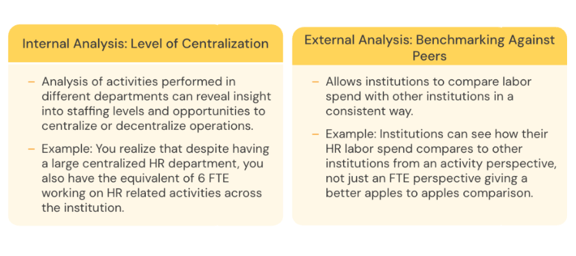Labor cost benchmarking data can be powerful in its ability to enable you to gain visibility into critical financial and workforce insights. By measuring academic and administrative labor costs and allowing our members to benchmark both internally and against members, institutions have the financial data and insights needed to position themselves for success. Some common uses include:
- Manage labor spend to support cost containment, strategic investment, and the effective delivery of administrative services
- Inform key finance processes with data like annual budgeting
- Demonstrate institutional financial sustainability and provide evidence of fiscal responsibility for accreditation
When socialized broadly, it can also be a tool effectively used across the institution in academic and administrative units. However, in order to set yourself up for success, you'll need to make sure your colleagues on campus understand all the value it can provide. Getting buy-in from the outset and at the point of purchase, can also contribute to facilitating usage post-implementation.
Read on for the 3 steps we recommend in order to help build buy-in across the institution during the purchasing process.
Create a goal to guide usage for your benchmarking data
There are lots of ways labor cost benchmarking data can be used. What is the best fit for your institution? Investigate and decide how you think your institution can use the data and set a goal. If you're still considering your options, check out this post with ideas for how to put the insights to use at your college.
Gather stakeholders to get their ideas
Once you have a sense for how you think your institution will be able to use the data, gather your stakeholders together and share some options. These stakeholders often include financial leadership, HR, and academic leadership. Together, you can validate your initial ideas and put a plan in place to use the data on a regular basis. As a group, you may even come up with some new ones!
Understand the methodology
Along with incorporating stakeholder ideas, you'll want to be transparent and generate trust in the data by making sure everyone understands where its coming from and what's being measured. Part of what sets our Benchmarking Consortium data apart is how we make it easy to apply an activity-based approach across all roles, functions, and departments. We consistently map your labor spend data into a Standard Activity Model (SAM), which enables you to compare your spending with other members, as well as within your own institution using a common set of analysis factors and characteristics.
We typically see that departmental budgeting approaches limit visibility into true labor spending patterns, which reinforces siloes and encourages duplication of job activities.
Benefits of an activity based approach

Once you've generated support across the institution, rolling out the platform post-purchase will be easier than ever. Here are the items to consider as you determine how to grant access to the labor cost data.
- Share the institution's goals for the data and the purchasing process. You'll likely be pulling in people, like leadership across schools and colleges, who were not involved so you'll want to surface your review process to build that trust and transparency in the data.
- Determine who needs access based on your institutional goals for usage. Perhaps you only want the data to sit with Finance or HR stakeholders. You also may want to share broadly across academic departments.
- Training, training, and more training. Once you've determined who will be accessing the platform, you'll need to train those staff so you have power users who can answer questions on an ongoing basis. You can also tap into the consortium member network to share training tips and tricks. Our members frequently gather virtually and in-person throughout the year to share the latest research, discuss current challenges, and celebrate success stories. You can utilize these avenues to connect with others and see how they are tackling training and using the platform.
- Check in on progress! Once your team starts using the labor cost benchmarking data regularly, make sure you are circling back to see how it's shaping decision-making. Have there been adjustments in hiring strategies? Has a new process been established or a budget process informed?
The clearer your roadmap is for securing buy-in for your benchmarking membership, the easier it is to carve out a path for success once the purchase is completed. Understanding how you'll use the data and building support internally are critical to getting the most value out of your membership.
For more inspiration, see how finance leaders from Auburn University and University of Alabama are putting their labor cost benchmarking data to use to make more precise financial decisions.


